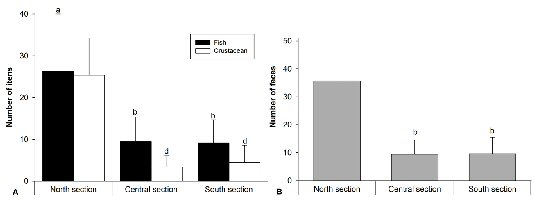IUCN/SSC Otter Specialist Group Bulletin

|
IUCN/SCC Otter Specialist Group Bulletin Volume 27 Issue 1 Pages 1 - 57 (January 2010) Citation: Carvalho-Junior, O., Macedo-Soares, L.C.P. de and Birolo, A.B. (2010). Annual and Interannual Food Habits Variability of a Neotropical Otter (Lontra longicaudis) Population in Conceição Lagoon, South of Brazil. IUCN Otter Spec. Group Bull. 27 (1): 24 – 32 Annual and Interannual Food Habits Variability of a Neotropical Otter (Lontra longicaudis) Population in Conceição Lagoon, South of Brazil Oldemar Carvalho-Junior1, Luis C.P. de Macedo-Soares2 and Alesandra Bez Birolo3 1Instituto
Ekko Brasil, IEB, Brazil. Email: atendimento@ekkobrasil.org.br |


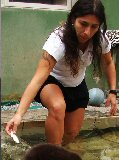 |
|
Abstract: This work studies the monthly and annual diet composition and variability of an otter population living at Conceição Lagoon, Santa Catarina Island, south of Brazil. Analysis of food item proportion through the years reveals that fish and crustacean are the main food items, followed by mollusks, birds and mammals. The results do not show interannual or monthly variability for the items that compose the otter’s diet within the study area. However, interannual and monthly spatial variability is found throughout the area. |
| Keywords:diet, distribution, long term analysis, numeric analysis |
| Française | Español |
INTRODUCTION
The river otter (Lontra longicaudis) is considered an endangered species by the Convention on International Trade in Endangered Species of Wild Fauna e Flora (CITES) and U.S. Endangered Species Act (USESA). In Brazil, the Fauna Protection Law that prohibits the commerce of products made from animals protects the otter. Reports indicate that these animals are not popular in some sectors of society. Fishermen and aquacultures, for example, claim that otters are prejudicial; damaging nets, eating cultivated fishes, and impacting mussel and oyster farms (Alarcon and Simões-Lopes, 2003; Trindade, 1991). At the same time, looking at the literature we don’t find any substantial information that would clarify such problems, making clear the need for further studies about the species.
Though a number of studies on diet have been published, these are based on short periods of data collection (Kasper et al., 2008; Uchôa et al., 2004; Quadros and Monteiro-Filho, 2001; Quadros and Monteiro-Filho, 2000). The purpose of this work is to define the diet composition of the species in a coastal lagoon in the south of Brazil, Conceição Lagoon, Santa Catarina Island (Figure 1), describing possible annual and interannual variability, as well as describing differences at the spatial distribution level.
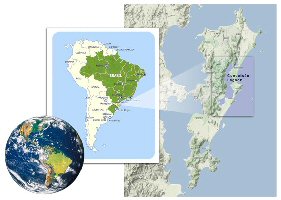 |
| Figure
1. Location
of the study area, South America, Brazil, Santa Catarina State,
Santa Catarina Island with Conceição Lagoon. (click for larger version) |
The Conceição Lagoon is located on the eastern border of Santa Catarina Island, just below the Tropic of Capricorn, at latitude 27º34’S and longitude 48º27’W. It extends in a North-South direction, with a total length of 13.5km, a width between 2.5km and 0.15km, and a total area of approximately 20km2. Different depths can be found in the study area: the average being roughly 1.7 m, and the maximum being approximately 8.8 m (Muehe and Gomes, 1989; Carvalho-Junior, 2008) (Figure 2). It is classified as a lagoon because it is made up of salt water and maintains a permanent communication with the ocean through the Barra da Lagoa channel. The salinity can vary from a minimum average of 6.70 to a maximum average of 18.50 (Martini et al, 2006; Fonseca et al, 2002).
 |
| Figure 2. Bathymetry of the study area. (click for larger version) |
Three sections are defined to study the area, one in the south, one in the centre, and another in the north (Figure 3). The north portion of the lagoon is part of a State Park (Rio Vermelho Park) and well protected. The remaining portion of the lagoon is a popular area for tourism and nowadays is seen as a suburb of Florianópolis.
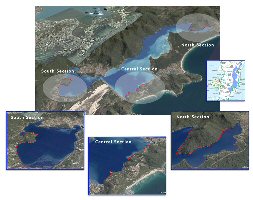 |
| Figure 3. Sampled sections in the study area. Three sections are defined: South Section, Central Section and North Section. (click for larger version) |
The Conceição Lagoon represents an important scenic resource of great ecological, economic and scientific value. Its interior is comprised of different types of habitat that function as breeding grounds and protection for different species; it is a very fragile and complex ecosystem. Throughout the year it is a tourist destination and the site of recreational activities, water sports and fishing. Unfortunately, urban development, without proper planning, lead to a negative impact on water quality resulting in habitat destruction and sedimentation.
The impacts of urbanization on the otter's population, as well as the role that the species plays in the area, are not known. Knowing the food habits of Lontra longicaudis is important information in the conservation of the species in the region.
MATERIALS AND METHODS
Diet composition was determined from 2516 samples of feces collected and analyzed from 2004 to 2008, except in North Section in 2004, representing 60 months. The section areas were covered using canoes and kayaks and the material collected was placed in small plastic bags, and stored in a refrigerator (Figure 4). In the lab, each sample was washed through mesh and the contents described as fish, crustacean, mollusk, bird and mammal.
 |
| Figure 3. The section areas were covered using canoes and kayaks (a), searching for signs like footprints (b) and feces (c). (click for larger version) |
The food item proportion was used in order to measure the importance of each item in the otter’s diet for years and months in each year. It was calculated for each food item using the total number for the food item in relation to the total of all food items. Unifactorial ANOVA was applied to determine whether there were any significant differences in abundance of the main food items and number of feces for different years (2005 to 2008), months and sections. Bifactorial ANOVA was also applied to determine any interaction between years (2005 to 2007) and sections, and between months and sections. The Bartlett test was conducted to verify homogeneity of variances before each analysis and Tukey`s test was used to explain differences found on the ANOVA output. All count data were [log10(x+1)] transformed in order to stabilize the variance and fit the data to a normal distribution (Zar, 1996). The tests were performed on Statisticaã 7.0 (Statsoft Inc., 1984-2004).
RESULTS
In 3889 food items found in the samples, food item proportion through the years reveals that fish and crustacean are the main ones, followed by mollusks, birds and mammals (Figure 5). As can be seen in Figure 5, diet composition does not change significantly through the years.
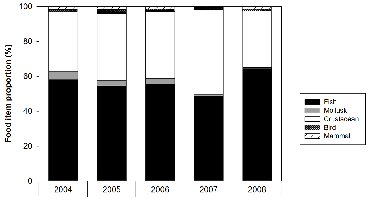 |
| Figure 5. Food item proportion (%) of the otter’s diet composition in the Conceição Lagoon from 2004 to 2008.. (click for larger version) |
The monthly variability of the diet composition from 2004 to 2007 is shown in Figure 6. ANOVA indicates that the food item of fish did not show differences between months of the year (F=0.819, P=0.621). However, the diet composition showed differences among sections (F=53.96, P<0.001).
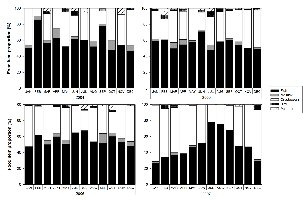 |
| Figure 6. Monthly food item proportion (%) variation of the items found in the otter’s feces in the Conceição Lagoon from 2004 to 2007. (click for larger version) |
Analysis from the Tukey`s test indicates that fish numbers were higher in the North Section (P=0.0002) as compared to Central and South sections (Figure 7A). The results did not indicate interannual differences between sections.
As with fish, ANOVA did not show significant differences for crustacean between years (F=0.70, P=0.552) and months (F=0.43, P=0.936). However, differences are again noticed comparing the sections (F=106.47, P<0.001). The Tukey`s test reveals that crustaceans were higher in the North Section (P=0.00002) (Figure 7A).
Bifactorial ANOVA detected no interaction for fish and crustacean considering year and section. These results indicate that in any year, the sampling should always result in predominance of these food items. The same analysis is applied for month and section, also showing no interaction between the two factors. For any month we should expect more fish and crustacean in the North Section.
Unifactorial ANOVA show no significant differences between years (F=3.16) and months (F=0.871) for number of feces. Considering the sections, the number of feces was higher in the North Section (F=128.338; P<0.001) (Figure 7B).
Bifactorial ANOVA applied in number of feces found significant differences between sections (F=96.082; P<0.001) for years versus sections. No significant differences were seen between years (F=0.554; P=0.577) or between the interaction of years and sections (F=0.694; P=0.598). The North Section presented higher number of feces with regard to the other two sections.
Significant differences are found between months (F=2.825; P=0.004) and sections (F=116.651; P<0.001). The interaction between these two shows no significant difference (F=0.996; P=0.480). When applying the Tukey`s test for months, it is found that August presents the highest average abundance of feces and October the lowest. The North Section shows the highest number of feces compared to Central and South sections.
DISCUSSION
The results do not show interannual or monthly variability for the items that compose the otter’s diet within the study area. These findings suggest a specific composition of the otter’s diet, in which fish and crustaceans are the main source of food, followed by mollusks, birds and mammals. It can be said that the otter’s diet does not change from year to year or month to month in the study area.
Crustaceans such as Farfantepenaeus paulensis (Pérez-Farfante, 1967), Farfantepenaeus brasiliensis (Latreille, 1817) (Decapoda, Penaeidae) (Lüchmann et al., 2008), and Callinectes danae (Smith, 1869) (Decapoda, Portunidae) (Branco and Masunari, 1992) are very common in the study area. Also, a common mollusk is the bivalve Anomalocardia brasiliana (Gmelin, 1791) (Mollusca, Bivalvia, Veneridae) (Pereira, 2003).
The Conceição Lagoon is particularly rich in fish with almost 40 families where Carangidae, Gerreidae, Gobiidae, Sciaenidae and Engraulidae are the most representatives (Ribeiro et al., 1999). Species associated with rocks and vegetation, such as those belonging to Gobiidae, Blenniidae and Cichlidae could be the most attractive in terms of availability to the otters. Previous studies in the Lagoa do Peri show the otter’s preference on fish (Tilapia and Geophagus, Cichlidae) and crustacean (Macrobrachium, Palaemonidade) suggesting that these preferences could be associated to a hunting strategy related to cost-benefit energy (Carvalho-Junior, 2007).
Crustacean and fish represent potential otter species prey in the area. At the same time, many of these species are economically important for the local fishing community. From 1970 to 1981 the fishery production of Conceição Lagoon reached a total of 335.2 tons/year, in which Mugil platanus and Mugil curema were the main contributors (Sierra de Ledo et al., 1999). It would be interesting to evaluate if there are conflicts between otter and fishermen in the area.
At the moment we do not know which mollusks, gastropods or bivalves, the specific type of crustacean, or the dominant species of fish that were present in the feces. The continuity of the present research is taking into account these questions in order to improve the knowledge of the otter’s ecology within the study area.
As in the present case, the diet of the neotropical otter is defined from fecal analysis. Lack of evidence of hard parts of some prey might happen in the scats. In the rivers of Pantanal, for example, catfish respond as an important part of the otter diet (Kruuk, 2006). This particular species would be difficult to identify from hard parts in the otter feces.
Without exception, all works on neotropical otters in Brazil reveal that fish is dominant in the diet, normally followed by crustaceans (Helder and Andrade, 1997; Pardini, 1998; Quadros and Monteiro-Filho, 2001; Quintela et al., 2008). Otter’s preference of fish and crustacean in the Morato River and the Engenho River, Paraná State, was also reported by Uchôa et al. (2004). In this case, the authors also did not find monthly variation in diet composition.
Another study conducted on fresh water rivers in northern Santa Catarina State, shows the same otter’s preference of fish and crustacean (Quadros and Monteiro-Filho, 2001). The same pattern is found in Taquary Valley, Rio Grande do Sul State, where fish were present in 97.5% of total samples (Kasper et al., 2008). Alarcon and Simoes-Lopes (2004) working in a marine environment, South of Brazil, also confirm that fish and various species of crustacean are the main items in the diet of the neotropical otter.
This work also attempts to address how the species is distributed within the study area. For example, interannual and monthly spatial variability are found in between sections. The north area appears to be an important food source region. The reason for this could be the fact that this region is part of a state park (State Park of Rio Vermelho), resulting in an area that still keeps its original vegetation and better water quality (Carvalho-Junior et al., 2004). The area is also the base of the State Environmental Police and a centre for recovering wild animals.
The higher number of feces in the North Section suggests a preference by otters for this area. It is quite clear that this area plays a key role in the local otter population. This may be due to the fact that there is a greater availability of food for the animals, together with less urbanization.
In fact, some authors recognize that variability in dispersion within species can be related to resource dispersion. Density of food, heterogeneity and patchiness of the prey could explain the dispersion of otters in a given environment (Macdonald, 1983; Kruuk, 2006). The North Section presents the highest average concentration of nutrient (De Souza-Sierra et al., 1999). Overall, the concentration and distribution of nutrients in the Conceição Lagoon is strongly affected by the ingression of seawater through the channel and just after rain, in areas close to discharge of river and domestic effluents (De Souza-Sierra et al., 1999). However, spatial distribution of fish and crustacean in the Conceição Lagoon is poorly known. Trying to understand how the environment affects the dispersion of otters in the study area is still a difficult task.
As the home range of the neotropical otter follows a linear shape, along the edge of the water body, the use of canoes and kayaks was considered appropriate to monitor and collect samples within the sections. The sampled areas are located in areas with depths ranging from 0.5 to 3 meters and mostly rocky coastline, reached only by water.
Apart from all efforts of research, to date we can affirm that Lontra longicaudis is poorly known, and we are still ignorant about its ecology and biology. This situation makes critical the need for conservation of the species.
Acknowledgements - We would like to acknowledge Marcelo Tosatti for helping with the fieldwork and Neno Brazil for making the location and sections maps. We also thank the staff of the State Protection Environmental Police “Dr. Fritz Muller” at the Rio Vermelho State Park for their assistance. We are most grateful to Tammy Snyder for the comments and review of the text and to Gaelle Moisand Lachenal who kindly translate the abstract to French. Finally we thank the comments and suggestions made by the anonymous reviewer, which improved significantly the quality of the paper.
REFERENCES
Alarcon, G.G., Simões-Lopes, P.C. (2003).
Preserved versus degraded coastal environments: a case study of the
neotropical otter in the environmental protection area of Anhatomirim,
Southern Brazil. IUCN Otter Spec. Group Bull. 20(2):
6-18.
Alarcon, G.G., Simões-Lopes, P.C. (2004). The
Neotropical otter Lontra longicaudis feeding habits in a marine
coastal area, Southern Brazil. IUCN Otter Spec. Group Bull. 21(1):
24-30
Branco, J.O., Masunari, S. (1992). Crescimento de Callinectes
danae Smith (Decapoda, Portuidae) da Lagoa da Conceição,
Florianópolis, Santa Catarina, Brazil. Revta Bras. Zool. 9(1/2):
53-66.
Carvalho-Junior, O. (2008). Application of remote
sensing techniques to the determination of bathymetry in coastal lagoons. Revista
de Estudos Ambientais 10(1): 40-48.
Carvalho-Junior, O. (2007). No Rastro da Lontra Brasileira.
Bernuncia, Florianópolis. 112pp.
Carvalho-Junior,
O., Banevicius, N.M.S., Mafra, E.O. (2004). Distribution and
characterization of environments used by otters in the Coastal Region
of Santa Catarina State, Brazil. J. Coastal Research, 39: 1087-1089.
[Available from http://www.ekkobrasil.org.br accessed 17 March 2010]
De Souza-Sierra, M.M., Soriano-Sierra, E.J., Salim, J.R.S.
(1999). Spatial and temporal distribution of the nutrients
and Hydrological parameters of the Conceição Lagoon,
SC, Brazil. In: Ledo, B., Soriano-Sierra, E. (Eds.). O
Ecossistema da Lagoa da Conceição. FEPEMA. 4:
63-87.
Fonseca, A., Braga, E.S., Eichler, B.B. (2002). Distribuição
Espacial dos Nutrientes Inorgânicos Dissolvidos e da Biomassa
Fitoplanctônica no Sistema Pelágico da Lagoa da Conceição,
Santa Catarina, Brasil. Atlântica, 24(2):
69-83.
Helder, J and Andrade, H.K. (1997). Food and feeding
habits of the neotropical river otter Lontra longicaudis (Carnivora,
Mustelidae). Mammalia, 61: 193-203.
Kasper, C.B., Bastazini, V.A.G., Salvi, J.,
Grillo, H.C.Z. (2008). Trophic
ecology and the use of shelters and latrines by the Neotropical Otter
(Lontra longicaudis) in the Taquari Valley, Southern Brazil. Iheringia, 98(4):
469-474.
Kruuk, H. (2006). Otters. Ecology, Behaviour and Conservation.
Oxford University Press, New York. 265pp.
Lüchmann, K.H., Freire, A.S., Ferreira, N.C., Daura-Jorge,
F.G., Marques, M.R.F. (2008). Spatial and temporal variations
in abundance and biomass of penaeid shrimps in the subtropical Conceição
Lagoon, southern Brazil. J. Marine Biol. Ass. UK 88(2):
293-299.
Macdonald, D.W. (1983). The
ecology of carnivore social behaviour. Nature, London, 301:
379-384.
Martini, L.C.P., Mattos, D.S., Barbosa, D.F.P., Rech, A.I.B.
(2006). Use of orbital remote sensing in the assessment of
spatial distribution of chlorophyll-a in Lagoa da Conceição
- Florianópolis, SC. Eng. Sanit. Ambient.11(4):
318-324.
Muehe, D., Gomes FC Jr (1989).
Batimetria e Algumas Considerações Sobre a Evolução
Geológica
da Lagoa da Conceição, Ilha de Santa Catarina, SC, Brasil.
In: Ledo, B., Soriano-Sierra, E. (Eds.). O Ecossistema
da Lagoa da Conceição. FEPEMA. 4:
15-24.
Pardini, R. (1998).
Feeding ecology of the neotropical otter Lontra longicaudis in
an Atlantic forest stream, south Brazil. J. Zool. London, 245:
385-391.
Pereira, N.C. (2003).
Diagnóstico ambiental
da Lagoa da Conceição utilizando o berbigão Anomalocardia
brasiliana (Gmelin, 1791) como bioindicador de poluição
aquática. Dissertação (Mestrado) - Universidade
Federal de Santa Catarina, Centro Tecnológico. Programa de Pós-Graduação
em Engenharia Ambiental, Florianópolis. 91pp.
Quadros, J., Monteiro-Filho, E.L.A. (2001).
Diet of the neotropical otter, Lontra longicaudis, in the
Atlantic Forest, Santa Catarina State, Southern Brazil. Stud. Neotrop. Fauna
Environ. 36(1): 15-21.
Quadros, J., Monteiro-Filho, E.L.A. (2000).
Fruit occurrence in the diet of the Neotropical Otter, Lontra longicaudis,
in the Southern Brazilian Atlantic Forest and its implication for seed
dispersion. I. J. Neotrop. Mammal. 7(1):
33-36.
Quintela, F.M., Porciúncula,
R.A., Colares, E.P. (2008).
Diet of Lontra longicaudis(Olfers) in a coastal stream in
southern Rio Grande do Sul State, Brazil. Neotrop. Biol. Cons., 3(3):
119-125.
Ribeiro, G.C., Clezar, L., Hostim-Silva, M. (1999).
Ichthyological community, spatial and seasonal variation in the Conceição
Lagoon and Coastal Adjacent Area, Santa Catarina Island, Brazil. In: Ledo,
B.S. and Soriano-Sierra, E. (Eds.).
O Ecossistema da Lagoa da Conceição. Florianópolis,
NEMAR, CCB, UFSC. SDM/FEPEMA. pp. 261-273.
Sierra de Ledo, B, Gré,
J.C.R. and Soriano-Sierra, E.J. (1999). Fishery production, anthropogenic and natural
stressors in Conceição Lagoon, Santa Catarina, Brazil.
In: Ledo, B.S. and Soriano-Sierra, E. (Eds.). O Ecossistema
da Lagoa da Conceição. Florianópolis, NEMAR, CCB,
UFSC. SDM/FEPEMA. pp 359-370.
Trindade, A. (1991).
Fish Farming and Otters in Portugal. IUCN Otter Spec. Group Bull. 6:
7-9.
Uchôa, T., Vidolin, G.P.,
Fernandes, T.M., Velastin, G.O.,
Mangini, P.R. (2004). Aspectos ecológicos e sanitários
da lontra (Lontra longicaudis OLFERS, 1818) na Reserva Natural
Salto Morato, Guaraqueçaba, Paraná, Brasil. Cad.
Biodivers. 4(2): 19-28.
Zar, J. H. (1996). Biostatistical
analysis. 3 ed. Prentice Hall, New Jersey. 662pp.
Résumé : Variabilité Annuelle
et Inter-Annuelle des Habitudes Alimentaires d'une Population de
Loutre (Lontra Longicaudis) Néo-Tropicale dans le Lagon de
Conceiçào, au sud du Brésil
Ce travail s'intéresse à la composition et la variabilité du
régime alimentaire mensuel et annuel d'une population de loutres
vivant au lagon de Conceiçào, sur l'île de Santa
Catarina, au sud du Brésil. La fréquence numérique à travers
les années révèle que les poissons et les crustacés
sont les principaux éléments, suivis par les mollusques,
les oiseaux et les mammifères. Les résultats ne montrent
pas de variabilité entre les mois ni les années pour
les éléments qui composent le régime alimentaire
des loutres dans l'écosystème étudié. Cependant,
une variabilité spatiale inter-annuelle et mensuelle a été constatée
dans cette zone.
Revenez au dessus
Resumen: Variabilidad
Annual y Inter-Annual en Habitos Alimentarios de una Población
de Nutrias Neotropicales (Lontra longicaudis) en la Laguna Conceição
al Sur de Brasil
Este trabajo estudia la composición y la variabilidad mensual
y anual de una población de nutrias en la laguna Conceição,
en la isla de santa Catarina al sur de Brazil. La frecuancia numérica
a través de los años indica que peces y crustaceos son
el alimento principal, seguidos por moluscos, aves y mamíferos.
Los resultados no muestra variabilidad mensual o inter-annual en la
composición alimentaria de las nutrias en el área de
estudio. Sin embargo, se evidenció variabilidad espacial mensual
e inter-annual a lo largo del área.
Vuelva a la tapa
